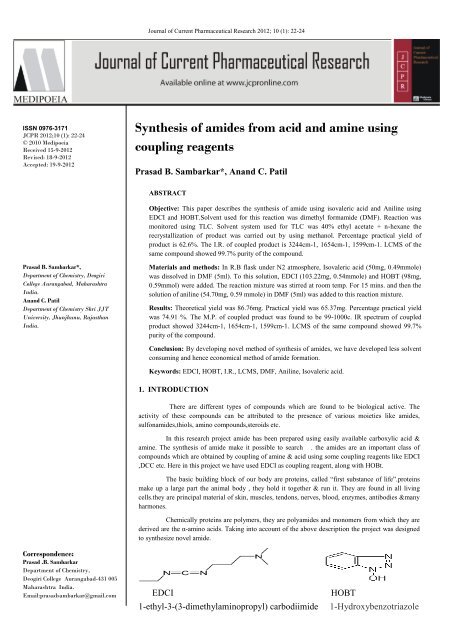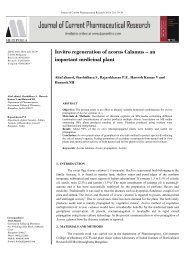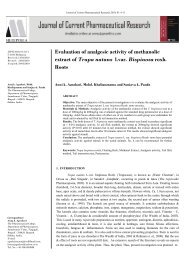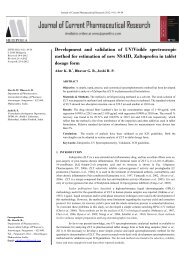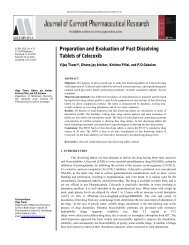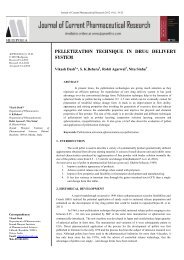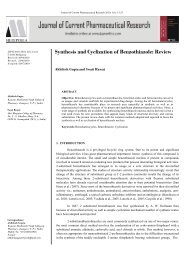Synthesis of amides from acid and amine using - Journal of Current ...
Synthesis of amides from acid and amine using - Journal of Current ...
Synthesis of amides from acid and amine using - Journal of Current ...
Create successful ePaper yourself
Turn your PDF publications into a flip-book with our unique Google optimized e-Paper software.
<strong>Journal</strong> <strong>of</strong> <strong>Current</strong> Pharmaceutical Research 2012; 10 (1): 22-24<br />
ISSN 0976-3171<br />
JCPR 2012;10 (1): 22-24<br />
© 2010 Medipoeia<br />
Received 15-9-2012<br />
Revised: 18-9-2012<br />
Accepted: 19-9-2012<br />
<strong>Synthesis</strong> <strong>of</strong> <strong>amides</strong> <strong>from</strong> <strong>acid</strong> <strong>and</strong> <strong>amine</strong> <strong>using</strong><br />
coupling reagents<br />
Prasad B. Sambarkar*, An<strong>and</strong> C. Patil<br />
ABSTRACT<br />
Objective: This paper describes the synthesis <strong>of</strong> amide <strong>using</strong> isovaleric <strong>acid</strong> <strong>and</strong> Aniline <strong>using</strong><br />
EDCI <strong>and</strong> HOBT.Solvent used for this reaction was dimethyl formamide (DMF). Reaction was<br />
monitored <strong>using</strong> TLC. Solvent system used for TLC was 40% ethyl acetate + n-hexane the<br />
recrystallization <strong>of</strong> product was carried out by <strong>using</strong> methanol. Percentage practical yield <strong>of</strong><br />
product is 62.6%. The I.R. <strong>of</strong> coupled product is 3244cm-1, 1654cm-1, 1599cm-1. LCMS <strong>of</strong> the<br />
same compound showed 99.7% purity <strong>of</strong> the compound.<br />
Prasad B. Sambarkar*,<br />
Department <strong>of</strong> Chemistry, Deogiri<br />
College Aurangabad, Maharashtra<br />
India.<br />
An<strong>and</strong> C. Patil<br />
Department <strong>of</strong> Chemistry Shri JJT<br />
University, Jhunjhunu, Rajasthan<br />
India.<br />
Materials <strong>and</strong> methods: In R.B flask under N2 atmosphere, Isovaleric <strong>acid</strong> (50mg, 0.49mmole)<br />
was dissolved in DMF (5ml). To this solution, EDCI (103.22mg, 0.54mmole) <strong>and</strong> HOBT (98mg,<br />
0.59mmol) were added. The reaction mixture was stirred at room temp. For 15 mins. <strong>and</strong> then the<br />
solution <strong>of</strong> aniline (54.70mg, 0.59 mmole) in DMF (5ml) was added to this reaction mixture.<br />
Results: Theoretical yield was 86.76mg. Practical yield was 65.37mg. Percentage practical yield<br />
was 74.91 %. The M.P. <strong>of</strong> coupled product was found to be 99-1000c. IR spectrum <strong>of</strong> coupled<br />
product showed 3244cm-1, 1654cm-1, 1599cm-1. LCMS <strong>of</strong> the same compound showed 99.7%<br />
purity <strong>of</strong> the compound.<br />
Conclusion: By developing novel method <strong>of</strong> synthesis <strong>of</strong> <strong>amides</strong>, we have developed less solvent<br />
consuming <strong>and</strong> hence economical method <strong>of</strong> amide formation.<br />
Keywords: EDCI, HOBT, I.R., LCMS, DMF, Aniline, Isovaleric <strong>acid</strong>.<br />
1. INTRODUCTION<br />
There are different types <strong>of</strong> compounds which are found to be biological active. The<br />
activity <strong>of</strong> these compounds can be attributed to the presence <strong>of</strong> various moieties like <strong>amides</strong>,<br />
sulfon<strong>amides</strong>,thiols, amino compounds,steroids etc.<br />
In this research project amide has been prepared <strong>using</strong> easily available carboxylic <strong>acid</strong> &<br />
<strong>amine</strong>. The synthesis <strong>of</strong> amide make it possible to search . the <strong>amides</strong> are an important class <strong>of</strong><br />
compounds which are obtained by coupling <strong>of</strong> <strong>amine</strong> & <strong>acid</strong> <strong>using</strong> some coupling reagents like EDCI<br />
,DCC etc. Here in this project we have used EDCI as coupling reagent, along with HOBt.<br />
The basic building block <strong>of</strong> our body are proteins, called “first substance <strong>of</strong> life”.proteins<br />
make up a large part the animal body , they hold it together & run it. They are found in all living<br />
cells.they are principal material <strong>of</strong> skin, muscles, tendons, nerves, blood, enzymes, antibodies &many<br />
harmones.<br />
Chemically proteins are polymers, they are poly<strong>amides</strong> <strong>and</strong> monomers <strong>from</strong> which they are<br />
derived are the α-amino <strong>acid</strong>s. Taking into account <strong>of</strong> the above description the project was designed<br />
to synthesize novel amide.<br />
Correspondence:<br />
Prasad .B. Sambarkar<br />
Department <strong>of</strong> Chemistry,<br />
Deogiri College Aurangabad-431 005<br />
Maharashtra India.<br />
Email:prasadsambarkar@gmail.com<br />
EDCI<br />
1-ethyl-3-(3-dimethylaminopropyl) carbodiimide<br />
HOBT<br />
1-Hydroxybenzotriazole
<strong>Journal</strong> <strong>of</strong> <strong>Current</strong> Pharmaceutical Research 2012; 10 (1): 22-24<br />
2. METERIALS AND METHODS:<br />
In R.B flask under N2 atmosphere, Isovaleric<br />
<strong>acid</strong>(50mg,0.49mmole) was dissolved in DMF (5ml). To this<br />
solution, EDCI (103.22mg, 0.54mmole) <strong>and</strong> HOBT (98mg,<br />
0.59mmol) were added. The reaction mixture was stirred at room<br />
temp. for 15 mins. <strong>and</strong> then the solution <strong>of</strong> aniline (54.70mg, 0.59<br />
mmole) in DMF (5ml) was added to this reaction mixture.<br />
The ethyl acetate layer was washed with 10% HCl<br />
solution <strong>and</strong> two layers were separated. It was then washed with<br />
10ml <strong>of</strong> brine solution. The ethyl acetate layer was dried over<br />
anhydrous sodium sulfate <strong>and</strong> evaporated in vacuum to give<br />
coupled compound. It yielded crude product (67mg). It was<br />
recrystallized by methanol. Its purity was determined by TLC. The<br />
I.R. <strong>of</strong> coupled product is 3244cm-1,1654cm-1, 1599cm-1. LCMS<br />
<strong>of</strong> the same compound showed 99.7% purity <strong>of</strong> the compound.<br />
+<br />
EDCI/HOBT<br />
3. RESULTS AND DISCUSSIONS:<br />
Theoretical yield was 86.76mg.<br />
Practical yield was 65.37mg.<br />
Percentage practical yield was 74.91 %.<br />
The M.P. <strong>of</strong> coupled product was found to be 99-1000c.<br />
IR spectrum <strong>of</strong> coupled product showed 3244cm-1,1654cm-1,<br />
1599cm-1.<br />
LCMS <strong>of</strong> the same compound showed 99.7% purity <strong>of</strong> the<br />
compound.<br />
Reaction was monitored <strong>using</strong> TLC. To this reaction<br />
mixture, 20 ml ethyl acetate was added. It was washed with 10%<br />
aqueous solution. <strong>of</strong> sodium bicarbonate. Two layers were<br />
separated properly.<br />
4. CONCLUSION:<br />
By developing novel method <strong>of</strong> synthesis <strong>of</strong> <strong>amides</strong>, we<br />
have developed less solvent consuming <strong>and</strong> hence economical<br />
method <strong>of</strong> amide formation.
<strong>Journal</strong> <strong>of</strong> <strong>Current</strong> Pharmaceutical Research 2012; 10 (1): 22-24<br />
5. REFERENCES:<br />
I.R spectrum <strong>of</strong> coupled product<br />
Balcom,Peterson,journal <strong>of</strong> organic chemistry,1989,54<br />
(1922)<br />
Castro B., Dormoy J.R., Evin.J., Selve C., Tetrehedron<br />
Lett. 1975, 1219-1222.<br />
Ilan pi-Bara <strong>and</strong> Jeffery schwattz chem..com,<br />
1997,4(347).<br />
Kim .M.H.,Patel D.V., Tett. Lett., 1994, vol 35, 5603-<br />
5606.<br />
Novabiochem catalogue, 2002-2003, 2.64-2.65.<br />
Organic synthesis,1999,76(57-76)<br />
Paul walts, Charlotte wiles, Stephen J.haswells, Esteban<br />
Pambohills, Chem.com.,2001,290-291<br />
Sliedregt K.M., Schouten.A., Kroon.J.,<br />
Liskamp.R.M.J.,Tett.lett., 1996,37,4237-4240.<br />
Takashashi, Toshjuki, Suzuki, Hirama, Tetrahedron,<br />
1994,507.


